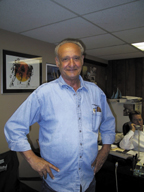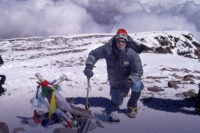

Walls & Ceilings: How did you get into this field (plastering and EIFS)?
Darreyl Johnson: I married my high school sweetheart and her whole family was in plastering. And I didn't want to be a plasterer. This was in Fort Wayne, Ind. When I started in it, I thought, "Oh no, this isn't what I want to do." But the more I got into it, the more I found it to be an art form. Now you're creating some kind of look; an aesthetic people can enjoy.
I spent four years as an apprentice. Now I'm pretty proud of who I am. Where I lived in Fort Wayne, the winters got pretty cold. And we were coming out of an era to when everything inside buildings was all plaster and we could work yearlong. The word "drywall" had just come onto the scene, this was roughly 1950. Needless to say, it took over the inside of buildings almost 80 percent.
So, we lost our inside work in the wintertime and I had to migrate to Florida. That started my career of moving around. I went from Florida, to California, to Texas and I got this feel for movement. Each time I did it, I got a little bit more experience.
Back in the early '70s, there was a chance to go to Saudi Arabia to supervise a plastering job. I went there and there were 150 of us supervisors and all the work force were Philippinos. The Philippines didn't have enough work to keep them: Some of these people were doctors and lawyers doing electrical work, plumbing, etc. They can make more money in the construction industry than they can in their own profession. So we had this big work force and we'd supervise our own particular trades. I stayed there about a year.
After I came back from there, I was working as a superintendent in Phoenix. And, one day I get a call from the Dryvit Co. They said they'd like to fly me out to Rhode Island. I flew there and met with Frank Gencarelli and Frank Morsilli. They knew I'd spent a year in Saudi Arabia and mentioned that they had projects over there and were finding it hard for people to go over there and work. Well, I am a plasterer. Anyhow, they told me about this project Alcover, which is outside of Thjarhan.
So I went to Saudi Arabia and worked for a company that was out of Beirut. While on the job site, we had a set of blue prints. And I said to a guy I worked with, "Rishick, where is this building?"
He said, "This is the building."
I said, "This ain't the building-here's the blueprints."
He said, "Well, it's a little different."
The building was totally different, so I had to redesign it on the spot, and we had to make all kinds of improvements on the polystyrene to fit over beams that shouldn't have been there. Long story short, it was another learning experience. They also designed a block of EPS polystyrene that was 32 inches thick, 24 inches high that just stuck around the top of the building for a kind of ornamentation. I said, "That's too much, you just can't stick it." So, I put a lot of adhesion on the back and stuck it to the top. I wrapped the mesh around and locked it back on the parapet, and put rebar with 2x4s and put pressure on it to hold its set up. And I'm scared to death that it's not gonna be strong, but I'm in Saudi Arabia, so what can I do?
Well, two or three days later, I look at Rishick and said, "I'm concerned with that big block up there."
"Mr. Johnson, much strong, much strong," he replied.
He had a guy up there jumping up and down making sure it would hold.
So then, after this, I go back and work in Tucson, Ariz., as a superintendent, and get another call from Dryvit. Same deal, we need you to go to King Cattle Military City, near the Iraqi border. I did that project, came back, this time Morsilli called me, and said "You know, I think you should work for us."
W&C: How did you meet Bob Thomas?
D.J.: How I met Bob Thomas is another story. Bob had set up a lot of the original EIFS test procedures. No one had made up these tests before Dryvit, so we had to create all these tests, such as fire-proofing, moisture, penetration, and here was the opportunity we had. We knew there was going to be competition coming down the line. So Bob-along with the other people he worked with-designed the toughest test known. So we all thought, "We could pass them, but could the other guys pass them?" So Bob designed some that are still used today that are still valid.
W&C: What is your current position?
D.J.: I'm a field service manager, which means at the start of the job I go out and see if all the designs are functional. Like the Commonwealth Hotel in Boston. This is a drainage system. The systems are designed for no water to get in at all. But if incidental water gets in, it needs a place to exit. So I go up, look at the design, the trims, and how this thing is going to function. Periodically I inspect a job-EPS, mesh, basecoat, finish, whatever-and at the end of it, I'm responsible for issuing the warranty on that job. That's one of my faces.
W&C: What kind of things do you think we could do to improve the industry?
D.J.: We have to go back to the Yellow Brick Road. We've got to get our material, products back to quality. We've got to service our people. We've got to become a family again. And who's the family? The family is the manufacturer and the customer. What has happened with the big conglomerates is they don't know who they're dealing with-to them it's all a bag of gold, that's all they want.
Where are we headed? Unless we get back to one-on-one in customer service and quality craftsmanship, we'll always be around, but we won't grow in market share, not at all. We've got to rethink who we are and where we're headed. The Carolina thing: When all that hit the fan, somebody made the statement, "I don't care which EIFS company you're with. Why don't we all go down as a team and resolve it as an industry team." If we change our ways, we will have a growing share of the exterior market.
W&C: Any thoughts on the insurance issue right now?
D.J.: I haven't been involved in that too much. Here's what I've experienced with the insurance companies: They really don't know what happened. And the competing industries-I'm not picking on anyone here-anybody that does a fa¿e of any kind, took an opportunity to take a shot. The insurance companies fell for it. Now they went back. You know, EIFS was banned in Carolina, in that particular area down there, for five years? They went back and re-evaluated that after five years-and the problem got worse-yet no EIFS was used so this is not an isolated EIFS problem.
Can you blame the insurance companies all the way? No. Can you blame the EIFS manufacturers up to a point? Absolutely. They should've incorporated all their talents and knowledge and went to the insurance companies and said, "Listen to us. This is the true story. You're insuring things now that are failing worse than we did. You're not raising premiums. We got a bad rap." The industry should address this issue, not individual companies.
W&C: Could any of this (the insurance dilemma) be helped through working with the general contractors more closely?
D.J.: Well, in most cases, we don't really have too many problems with the general contractor. The GC knows what his role is. All he requires from you is good application, timing to fit into his schedule and the right price, and as long as you schedule yourself to his time table, he's happy. The GC doesn't seem to be a hiccup in this whole thing.
We need more education in the field for the specifier, the designer and the engineer. Once they understand it, there are fewer problems. But there are a lot of people in the industry of general construction who don't understand the system.
W&C: Was the transition from plastering to EIFS
difficult?
D.J.: No. I started in the East plastering inside. As I migrated to the West, I got into plastering outside stucco. So going to exterior EIFS was not a problem. Mentally it was a problem. When I first came back from Saudi Arabia, and they said, "This is EIFS." I said, "Are you out of your mind? You think I'm putting a piece of foam like that on a building, on the outside?" And I had this plastering mentality of if it isn't thick and hard cement, then it isn't worth a damn. Anyhow, they finally talked me into doing a job. And I saw the flexibility, durability and ease of application.
You have to remember, a 6-foot to 8-foot rod of cement dragging up the side of a building when you're leveling and rodding it off. You've got to be a tough son of a gun. When you've got a piece of foam, and a little piece of rag, called mesh, you can do that till you're 90. So I saw the advantages of it, then I saw that thick and heavy doesn't count. You know, the thicker the wall, the more seismic activity is gonna make it crack and crumble. A wall that has flexibility and that can move around, it goes with the flow. So, as I saw the advantages, I came to respect the product for what it was.
W&C: Who should be using EIFS and who shouldn't?
D.J.: Well, the people who shouldn't be using it are the ones causing the most problems down in Carolina. Those individuals should not be blamed. They didn't know it. They weren't taught. EIFS is not something you can buy at the Home Depot and put up reading instructions. The schematics are pretty straightforward. But a lot of people, say well, "That doesn't make sense to do that," so they don't. What happened in Carolina was the companies-we all have to take a hit for it, because if we don't we're fools for it-there was so much EIFS being sold that Joe Blow in his pick-up truck came in and said, "Load it up."
"But you've never done it before."
"That's OK, we'll figure it out."
Well that "no problem" turned into one hell of a problem. Who shouldn't we be selling it to? Non-trained applicators should not be able to put up the EIFS until they go to school or seminar; then they have at least a general knowledge of it.
Who should we sell it to? A person who has gone through the effort to learn to do it correctly and what it takes to work so the aesthetics come out looking really good. So, a trained applicator. EIFS should not be a commodity.
W&C: Do you think you can mix manufacturers' products and still have a functional EIFS system?
D.J.: Even though it's basically all the same chemistry, some of the chemicals we use are incompatible with other products that may react differently. Mixing and matching is really not a good thing, because you don't want multiple warranties from different companies for one wall. I wouldn't mix and match.
Ever heard of the "High Standard Problem"? All the companies found a hell of an opportunity to buy mesh from France. And all at once we'd go on jobs, and the mesh would be off the wall flying in the wind. The plasticizer that they put on the mesh, which is similar to a synthetic plastic coating, was not fully bound with the product and the EPS, and would eat into the EPS, release itself and flip on the wall like a flag. Nobody tested this stuff. The point I'm trying to get at is, if you don't know where those components and your vendors are coming from, how can you tell what's going to happen?
W&C: How did US eifs start?
D.J.: Mike Travis and I came back from building an EIFS manufacturing plant in England and we decided I was going to go to South Africa to supervise a large prefabricated casino project. We spoke to Steve Lancia about setting up an EIFS manufacturing plant in Rhode Island. They said, "When you get back here we want you to help us get the R.I. plant going."
And I said, "What are we going to use? What formulas?"
They said, "We've got our own formulas."
We had purchased the assets of an existing EIFS company who got all caught up in the residential market in the Carolinas who wanted to sell their business. They had a great relationship with Rohm & Haas and could help us achieve our goal of manufacturing the highest quality EIFS product available. Rohm & Haas brought in its most experienced people, like John Rimmer and we worked together to develop the highest quality EIFS system utilizing E1 2000-a Rohm & Haas product.
We have seen first hand the problems associated with using inferior formulas and that is not where we want to be. Sure you can save some money but it's truly not worth it. Today we spend extra money on quality raw materials so that we are assured the best product on the market.
Mike and I have been together a long time, bouncing around the world and we simply wanted our own company. We just wanted a high-powered little team of experienced people. We have that with US eifs and we have been growing our business every month since our humble beginning.
Why don't I retire? Can you find this much excitement in a bottle of whiskey sitting in a rocking chair? W&C




Report Abusive Comment